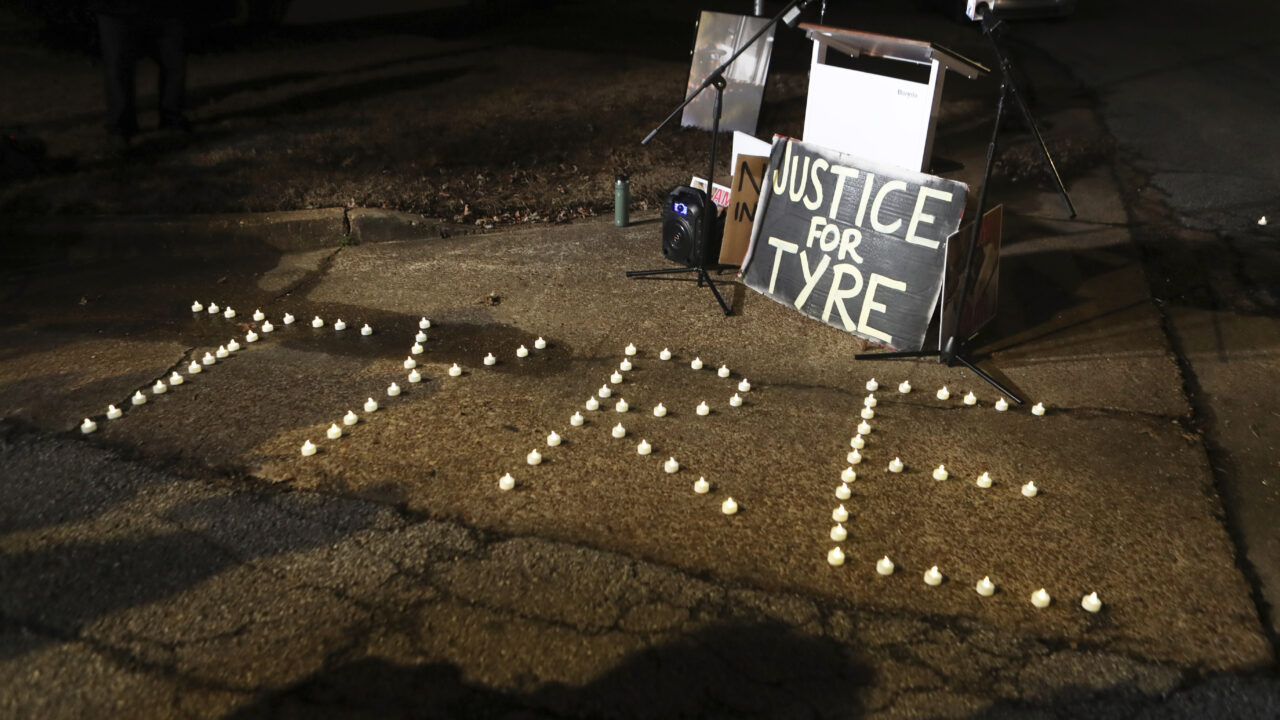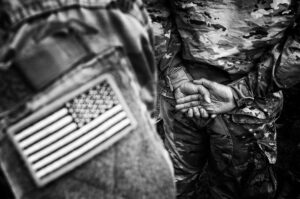The Impact of Police Violence on Community Health
The trauma created by police killings has lasting effects and can compound chronic illnesses. Candles spell out the name of Tyre Nichols during a candlelight vigil for Nichols on the anniversary of his death, Jan. 7, 2024, in Memphis, Tenn. (AP Photo/Karen Pulfer Focht, file)
Candles spell out the name of Tyre Nichols during a candlelight vigil for Nichols on the anniversary of his death, Jan. 7, 2024, in Memphis, Tenn. (AP Photo/Karen Pulfer Focht, file)
Editor’s note: On Jan. 30, the City of Memphis released additional videos of the fatal beating of Tyre Nichols.
In the last three years, Andre, a 61-year-old Black man, has been pulled over by police at least five times. It has never been for a moving violation, he says, such as speeding or running a red light. Instead, the reasons have been more suspect. He characterizes them as “overpolicing” and “profiling.”
The most recent incident happened in September. Andre, who asked to be identified only by his middle name, was shadowed by an unmarked car with tinted windows on Raines Road. He thought it could be a police vehicle, but since he wasn’t speeding he didn’t think he could be subject to a police stop. The car pulled alongside him. He slowed down to let it pass, but the car slowed with him. He slowed down again, and the car slowed with him again.
“Tyre Nichols popped in my brain,” Andre said. “So I unbuckled my seatbelt, pulled out my phone, and I tried to call my family.”
Andre says he wasn’t sure what was happening until the police officer, who was also Black, flashed interior lights and signaled for him to pull over.
Andre thrust his arms out of the car window to show he was not holding a weapon.
After some confused negotiations about where he would put his hands, the officer cited him for not wearing a seatbelt.
A Harvard public health study suggested that the police killing of an unarmed Black person had a negative mental health effect on the African American community in the entire state.
In the year since Nichols’ beating death by five police officers, followed by the release of footage showing the event, there have been cries for justice, accountability and police reform. Yet less has been made of the toll his death — and the deaths of other Black people at the hands of police — may have taken on community health.
Social media and news coverage of police violence have created trauma that affects not only victims and their families but the wider community. A Harvard public health study suggested that the police killing of an unarmed Black person had a negative mental health effect on the African American community in the entire state. Other studies have specifically shown that watching videos of police violence disproportionately contributes to sleeplessness, feelings of being on guard and post-traumatic stress disorder symptoms in Black Americans.
And it’s not just the mind that’s affected.
“When you look at higher rates of diabetes or high blood pressure, cardiovascular disease, mortality rate [in the Black community], we can’t dismiss the impact of racialized trauma on our physical and psychological beings,” said Dr. Janet Taylor, a Florida-based psychiatrist.
In fact, studies have shown that stress caused by racial discrimination is associated with changes in the DNA of African Americans, which lead to premature aging on the cellular level, or “weathering.”
As for Andre, after his encounter with the police, he was hyperventilating and felt “despair.”
But he got home.
‘The scariest thing I ever saw’
Ways to cope with trauma and discrimination
In an interview with the Harvard Gazette, Harvard public health professor David Williams cited three studies that showed the importance for African Americans of social ties, religion and community activism in combating the negative mental effects of trauma and racial discrimination.
Psychiatrist Janet Williams adds that attention to the basics can have positive effects:
- “There’s no substitute for exercise and eating well,” which aid the brain, and “our brain is our biggest ally during stressful times.”
- Get a good night’s sleep.
- If you notice that what you watch on your screens is affecting you negatively, turn it off, don’t share the video and do something that makes you feel better.
- If your coping mechanisms are negative — drinking too much or doing drugs — get support or counseling.
- Shift your thinking: “Refocus on what’s going right and know how to give yourself some positivity.”
- Find daily hope in spirituality.
To find a therapist for racial trauma, see the resources in this article.
Trauma is defined in different ways but generally refers to experiences that cause intense physical and psychological stress reactions. PTSD, which occurs after a person has experienced or witnessed a distressing event, includes symptoms such as disturbing thoughts and feelings long after the event has passed, flashbacks, nightmares, feelings of sadness, fear or anger or feelings of detachment.
Taylor said that witnessing violence, whether directly or in videos broadcast on the news or through social media, can have a significant psychological and physical impact. This particularly impacts people who have previously experienced trauma.
“People who live in communities where they witness a lot of physical violence or emotional violence and abuse or racism — all those factors — it impacts your brain, which impacts your body,” she said. “So exposure to trauma, especially consistently, is a public health factor.”
The more trauma you witness or are involved in, the more your stress levels increase. Trauma has a cumulative effect, she said.
Andre says he wasn’t always afraid of the police. Growing up in Orange Mound, the retired FedEx employee had pleasant interactions with “Officer Friendly” — every neighborhood cop was Officer Friendly back then.
So he remembers being shocked by what he saw on a trip to see the play “Cats” in New York’s theater district. It was 20-some years ago when Rudolph Giuliani held the mayoral office. Giuliani had installed the infamous “stop and frisk” policy, and Andre saw police in Times Square grabbing “random Black men, slamming them against the wall and just start searching them.”
“That was the scariest thing I ever saw,” he said.
Until Jan. 27, 2023. On that Friday afternoon, Andre saw the chyrons scrolling on the bottom of his TV screen announcing the release of videos depicting the Jan. 7 beating of Nichols. The city was going to release the videos after 6 p.m., when people were home from work, to lessen, officials hoped, the chance of civil unrest. Andre made a point to run to Kroger well ahead of time. After he got home, he watched the footage on the news in his living room.
“I was traumatized,” he said, particularly when he saw the perpetrators were Black officers. “They should have been the ones that have more compassion than anyone.”
A 2020 study of the impact of police violence noted how several factors make it uniquely stress-inducing, including that it is state-sanctioned, there is limited recourse, police culture deters accountability and police are usually armed.
Harvard public health professor David Williams and others affirmed in a 2018 study the spillover effect of police violence on the Black community — how it harms not only those involved and their families but also those who have witnessed or heard about it. In cases where an unarmed Black person was killed by police, the researchers correlated worse mental health in the African American community in the whole state.
The negative mental health effects of a police killing among Black people were long-lasting, enduring three months. No effect was observed in the white community.
The fact that the police killing of Nichols was so evidently unjustified has created a fear in the Black community that “at any point, at any turn … I could experience great violence, and I have no way to avoid it,” said Josh Adams, field director of Memphis for All and a member of the steering committee for the official Black Lives Matter chapter in Memphis. “And I think that needs to be examined on a mental health level.”
Addressing trauma in the Downtown jail
Keedran Franklin, a professional organizer, said he intentionally avoided watching the full Nichols videos, though he has seen snippets. Through a program of the Shelby County Sheriff’s Office, in partnership with the nonprofit organization Inside Circle, begun last fall, Franklin facilitates weekly sessions to address trauma at the Shelby County Jail in Downtown Memphis. In these healing circles, gang members and other violent offenders discuss topics of their choice in a nonjudgmental environment. The goal is to reduce recidivism.
“In my circles, people are continuously dealing with those atrocities, so they don’t stop at Tyre Nichols,” he said. “There’s a lot of other stories like Tyre Nichols that never really made it to the light.”
He said both victims and police need to do the work to address their personal trauma: “getting into spaces where we can release and not get so caught up in the emotional baggage of the up and down and the grief.”
But the first step is to admit the trauma and the sadness. Otherwise, “it’s going to always come out as anger because that’s what’s acceptable to society,” Franklin said. “Society don’t make it acceptable for you to cry.”
Taking positive action
Andre agrees that many of his peers adhere to the “G” code, which holds that men should not show vulnerability. He feels that many acquaintances were afraid after the release of the Nichols videos but will not discuss it. He understands this — but is having none of it himself. Police scare him, he admits, and “I’m terrified for my son.”
His young adult son is autistic and takes medication that can make his movements erratic. Andre said he is afraid that one day his son might make a movement that will be interpreted as aggressive by police.
But Andre is taking action against police violence and a justice system where he feels ignored — a step that experts say can help people to move beyond their trauma.
The negative mental health effects of a police killing among Black people were long-lasting, enduring three months. No effect was observed in the white community.
Last summer, the Department of Justice initiated a civil rights investigation of Memphis and the Memphis Police Department to examine the use of force and its stops, searches and arrests, as well as whether it engages in discriminatory policing.
Andre attended a Department of Justice meeting for the public last fall, where he told investigators about his experiences. He said he is hopeful about the DOJ’s efforts and felt that his comments were taken seriously by the investigator he spoke with.
This is in stark contrast with his dealings with police and courtroom personnel.
He made the decision to fight his recent citation for not wearing a seatbelt. He went to court in October, but his case was not heard that day. An assistant district attorney encouraged him to just pay the $25 ticket, but Andre told him he wanted to tell the judge about his experience — that he wasn’t wearing a seatbelt as a result of being afraid of the officer.
“He was like, ‘Well how much did you pay to park?’ I said, ‘Twenty bucks.’ He said, ‘Man, if I was you, I’d just go pay the $25.’”
Andre refused and will pay another $20 for parking when his date comes around again.
He says he just wants to be heard.
Your support matters…Independent journalism is under threat and overshadowed by heavily funded mainstream media.
You can help level the playing field. Become a member.
Your tax-deductible contribution keeps us digging beneath the headlines to give you thought-provoking, investigative reporting and analysis that unearths what's really happening- without compromise.
Give today to support our courageous, independent journalists.






You need to be a supporter to comment.
There are currently no responses to this article.
Be the first to respond.